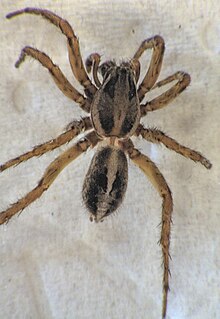
The Thomisidae are a family of spiders, including about 170 genera and over 2,100 species. The common name crab spider is often linked to species in this family, but is also applied loosely to many other families of spiders. Many members of this family are also known as flower spiders or flower crab spiders.

Wolf spiders are members of the family Lycosidae. They are robust and agile hunters with excellent eyesight. They live mostly in solitude, hunt alone, and do not spin webs. Some are opportunistic hunters, pouncing upon prey as they find it or chasing it over short distances; others wait for passing prey in or near the mouth of a burrow.

Nursery web spiders (Pisauridae) is a family of araneomorph spiders first described by Eugène Simon in 1890. They resemble wolf spiders (Lycosidae) except for several key differences. Wolf spiders have two very prominent eyes in addition to the other six, while a nursery web spider's eyes are all about the same size. Additionally, female nursery web spiders carry their egg sacs with their jaws and pedipalps instead of attaching them to their spinnerets as wolf spiders do. When the eggs are about to hatch, a female spider builds a nursery "tent", places her egg sac inside, and stands guard outside, hence the family's common name. Like the wolf spiders, however, the nursery web spiders are roaming hunters that don't use webs for catching prey.

Dictynidae is a family of cribellate, hackled band-producing spiders first described by Octavius Pickard-Cambridge in 1871. Most build irregular webs on or near the ground, creating a tangle of silken fibers among several branches or stems of one plant.
Pacullidae is a family of araneomorph spiders first described by Eugène Simon in 1894. It was merged into Tetrablemmidae in 1958, then raised back to family status after a large phylogenetic study in 2017.
Nukuhiva is a genus of spiders with a single species, Nukuhiva adamsoni, that occurs only on the Marquesas Islands in French Polynesia. It is in the wolf spider family, Lycosidae. It has been found on Nuku Hiva and on Ua Huka, a smaller island about 25 km (16 mi) to the east.

The Artoriinae are a subfamily of wolf spiders. The monophyly of the subfamily has been confirmed in a molecular phylogenetic study, although the relationships among the subfamilies was shown to be less certain.
Alistra is a genus of dwarf sheet spiders that was first described by Tamerlan Thorell in 1894.
Zoica is a genus of wolf spiders in the family Lycosidae, containing twelve species.
Artoria is a genus of spiders in the family Lycosidae. It was first described in 1877 by Thorell. As of 2017, it contains 32 species.
Dingosa is a genus of spiders in the family Lycosidae. It was first described in 1955 by Roewer. As of 2017, it contains 6 species from Australia and from South America.
Kangarosa is a genus of spiders in the family Lycosidae. It was first described in 2010 by Framenau. As of 2017, it contains 10 species from Australia.
Margonia is a genus of spiders in the family Lycosidae. It was first described in 1983 by Hippa & Lehtinen. As of 2017, it contains only one species, Margonia himalayensis, found in India.
Shapna is a genus of spiders in the family Lycosidae. It was first described in 1983 by Hippa & Lehtinen. As of 2017, it contains only one species, Shapna pluvialis, found in India.

Tasmanicosa is a genus of spiders in the family Lycosidae. It was first described in 1959 by Roewer. As of 2017, it contains 14 species, all from Australia.
Tuberculosa is a genus of spiders in the family Lycosidae. It was first described in 2006 by Framenau & Yoo. As of 2017, it contains 4 Australian species.

Venatrix is a genus of wolf spiders first described by Carl Friedrich Roewer in 1960.
Satta cannibalorum is a species of spiders in the family Lycosidae. It was first described in 1979 by Lehtinen & Hippa. As of 2017, it is the only species in the genus Satta. It is found in New Guinea.






